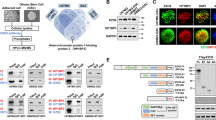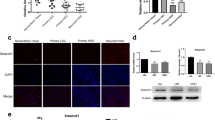Abstract
SET and MYND domain-containing protein 2 (SMYD2) is an important epigenetic regulator that methylates histone and non-histone proteins. The study aimed to investigate the oncogenic role of SMYD2 in gliomas and explore its degradation mechanism induced by cisplatin. Tumor tissue microarray of 441 patients with glioma was collected for SMYD2 immunohistochemical staining. Kaplan–Meier survival curves were constructed using the overall survival values. mRNA-sequencing analysis was performed for understanding the downstream mechanisms mediated by SMYD2. The half-inhibitory concentrations (IC50) of temozolomide and cisplatin in AZ505-treated and control cells were calculated. The potential E3 ubiquitin ligase of SMYD2 was predicted in UbiBrowser and confirmed by a knockdown test. The effect of SMYD2 and its E3 ligase on apoptosis and migration of glioma cells was determined via cell-function assays. High SMYD2 expression correlated with a high WHO stage (P = 0.004) and a low survival probability (P = 0.012). The inhibition of SMYD2 suppressed the process of epithelial to mesenchymal transition (EMT) by downregulating the expression of Collagen 1A1 (COL1A1). AZ505 treatment significantly increased the drug sensitivity of glioma cells. SMYD2 expression was markedly reduced by cisplatin treatment via STIP1 Homology And U-Box Containing Protein 1 (STUB1)-mediated degradation. The knockdown of STUB1 could partly reverse the cell function impairment induced by cisplatin. Our findings suggested that SMYD2 could be a potential drug target for the treatment of gliomas, and STUB1-mediated degradation of SMYD2 plays an important role in reversing chemotherapy resistance in patients with gliomas.






Similar content being viewed by others
References
Ahmed SF, Deb S, Paul I et al (2012) The chaperone-assisted E3 ligase C terminus of Hsc70-interacting protein (CHIP) targets PTEN for proteasomal degradation. J Biol Chem 287:15996–16006. https://doi.org/10.1074/jbc.M111.321083
Brown MA, Sims RJ 3rd, Gottlieb PD et al (2006) Identification and characterization of Smyd2: a split SET/MYND domain-containing histone H3 lysine 36-specific methyltransferase that interacts with the Sin3 histone deacetylase complex. Mol Cancer 5:26. https://doi.org/10.1186/1476-4598-5-26
Chen S, Kapilashrami K, Senevirathne C et al (2019) Substrate-differentiated transition states of SET7/9-catalyzed lysine methylation. J Am Chem Soc 141:8064–8067. https://doi.org/10.1021/jacs.9b02553
Cho HS, Hayami S, Toyokawa G et al (2012) RB1 methylation by SMYD2 enhances cell cycle progression through an increase of RB1 phosphorylation. Neoplasia 14:476–486. https://doi.org/10.1593/neo.12656
Connell P, Ballinger CA, Jiang J et al (2001) The co-chaperone CHIP regulates protein triage decisions mediated by heat-shock proteins. Nat Cell Biol 3:93–96. https://doi.org/10.1038/35050618
Du B, Shim JS (2016) Targeting epithelial-mesenchymal transition (EMT) to overcome drug resistance in cancer. Molecules. https://doi.org/10.3390/molecules21070965
Espinosa G, López-Montero I, Monroy F et al (2011) Shear rheology of lipid monolayers and insights on membrane fluidity. Proc Natl Acad Sci U S A 108:6008–6013. https://doi.org/10.1073/pnas.1018572108
Ferguson AD, Larsen NA, Howard T et al (2011) Structural basis of substrate methylation and inhibition of SMYD2. Structure 19:1262–1273. https://doi.org/10.1016/j.str.2011.06.011
Göbel A, Rauner M, Hofbauer LC et al (2020) Cholesterol and beyond—the role of the mevalonate pathway in cancer biology. Biochim Biophys Acta Rev Cancer 1873:188351. https://doi.org/10.1016/j.bbcan.2020.188351
Gonzalez DM, Medici D (2014) Signaling mechanisms of the epithelial-mesenchymal transition. Sci Signal 7:re8. https://doi.org/10.1126/scisignal.2005189.
Guo D, Reinitz F, Youssef M et al (2011) An LXR agonist promotes glioblastoma cell death through inhibition of an EGFR/AKT/SREBP-1/LDLR-dependent pathway. Cancer Discov 1:442–456. https://doi.org/10.1158/2159-8290.Cd-11-0102
Huang J, Perez-Burgos L, Placek BJ et al (2006) Repression of p53 activity by Smyd2-mediated methylation. Nature 444:629–632. https://doi.org/10.1038/nature05287
Ivanov GS, Ivanova T, Kurash J et al (2007) Methylation-acetylation interplay activates p53 in response to DNA damage. Mol Cell Biol 27:6756–6769. https://doi.org/10.1128/mcb.00460-07
Kim SM, Grenert JP, Patterson C et al (2016) CHIP(-/-)-mouse liver: adiponectin-AMPK-FOXO-activation overrides CYP2E1-elicited JNK1-activation, delaying onset of NASH: therapeutic implications. Sci Rep 6:29423. https://doi.org/10.1038/srep29423
Komatsu S, Ichikawa D, Hirajima S et al (2015) Overexpression of SMYD2 contributes to malignant outcome in gastric cancer. Br J Cancer 112:357–364. https://doi.org/10.1038/bjc.2014.543
Kukita A, Sone K, Oda K et al (2019) Histone methyltransferase SMYD2 selective inhibitor LLY-507 in combination with poly ADP ribose polymerase inhibitor has therapeutic potential against high-grade serous ovarian carcinomas. Biochem Biophys Res Commun 513:340–346. https://doi.org/10.1016/j.bbrc.2019.03.155
Lin CY, Huang KY, Lin YC et al (2021) Vorinostat combined with brigatinib overcomes acquired resistance in EGFR-C797S-mutated lung cancer. Cancer Lett 508:76–91. https://doi.org/10.1016/j.canlet.2021.03.022
Luan H, Mohapatra B, Bielecki TA et al (2018) Loss of the nuclear pool of ubiquitin ligase CHIP/STUB1 in breast cancer unleashes the MZF1-cathepsin pro-oncogenic program. Cancer Res 78:2524–2535. https://doi.org/10.1158/0008-5472.Can-16-2140
Ma HP, Chang HL, Bamodu OA et al (2019) Collagen 1A1 (COL1A1) is a reliable biomarker and putative therapeutic target for hepatocellular carcinogenesis and metastasis. Cancers (basel). https://doi.org/10.3390/cancers11060786
Nakakido M, Deng Z, Suzuki T et al (2015) Dysregulation of AKT pathway by SMYD2-mediated lysine methylation on PTEN. Neoplasia 17:367–373. https://doi.org/10.1016/j.neo.2015.03.002
Ostrom QT, Gittleman H, Xu J et al (2016) CBTRUS statistical report: primary brain and other central nervous system tumors diagnosed in the United States in 2009–2013. Neuro Oncol 18:v1–v75. https://doi.org/10.1093/neuonc/now207
Parsons JL, Tait PS, Finch D et al (2008) CHIP-mediated degradation and DNA damage-dependent stabilization regulate base excision repair proteins. Mol Cell 29:477–487. https://doi.org/10.1016/j.molcel.2007.12.027
Qiu Z, Yuan W, Chen T et al (2016) HMGCR positively regulated the growth and migration of glioblastoma cells. Gene 576:22–27. https://doi.org/10.1016/j.gene.2015.09.067
Ren H, Wang Z, Chen Y et al (2019) SMYD2-OE promotes oxaliplatin resistance in colon cancer through MDR1/P-glycoprotein via MEK/ERK/AP1 pathway. Onco Targets Ther 12:2585–2594. https://doi.org/10.2147/ott.S186806
Saddic LA, West LE, Aslanian A et al (2010) Methylation of the retinoblastoma tumor suppressor by SMYD2. J Biol Chem 285:37733–37740. https://doi.org/10.1074/jbc.M110.137612
Seo J, Han SY, Seong D et al (2019) Multifaceted C-terminus of HSP70-interacting protein regulates tumorigenesis via protein quality control. Arch Pharm Res 42:63–75. https://doi.org/10.1007/s12272-018-1101-8
Shang L, Wei M (2019) Inhibition of SMYD2 sensitized cisplatin to resistant cells in NSCLC through activating p53 pathway. Front Oncol 9:306. https://doi.org/10.3389/fonc.2019.00306
Shi W, Feng L, Dong S et al (2020) FBXL6 governs c-MYC to promote hepatocellular carcinoma through ubiquitination and stabilization of HSP90AA1. Cell Commun Signal 18:100. https://doi.org/10.1186/s12964-020-00604-y
Song J, Liu Y, Chen Q et al (2019) Expression patterns and the prognostic value of the SMYD family members in human breast carcinoma using integrative bioinformatics analysis. Oncol Lett 17:3851–3861. https://doi.org/10.3892/ol.2019.10054
Su J, Morgani SM, David CJ et al (2020) TGF-β orchestrates fibrogenic and developmental EMTs via the RAS effector RREB1. Nature 577:566–571. https://doi.org/10.1038/s41586-019-1897-5
Sun XL, Lv JL, Dou L et al (2020) LncRNA NEAT1 promotes cardiac hypertrophy through microRNA-19a-3p/SMYD2 axis. Eur Rev Med Pharmacol Sci 24:1367–1377. https://doi.org/10.26355/eurrev_202002_20194.
Tan AC, Ashley DM, López GY et al (2020) Management of glioblastoma: state of the art and future directions. CA Cancer J Clin 70:299–312. https://doi.org/10.3322/caac.21613
Theocharis AD, Skandalis SS, Gialeli C et al (2016) Extracellular matrix structure. Adv Drug Deliv Rev 97:4–27. https://doi.org/10.1016/j.addr.2015.11.001
Tomiyama A, Ichimura K (2019) Signal transduction pathways and resistance to targeted therapies in glioma. Semin Cancer Biol 58:118–129. https://doi.org/10.1016/j.semcancer.2019.01.004
Wang D, Ma L, Wang B et al (2017) E3 ubiquitin ligases in cancer and implications for therapies. Cancer Metastasis Rev 36:683–702. https://doi.org/10.1007/s10555-017-9703-z
Wang H, Song X, Liao H et al (2020a) Overexpression of SMAD7 activates the YAP/NOTCH cascade and promotes liver carcinogenesis in mice and humans. Hepatology. https://doi.org/10.1002/hep.31692
Wang Q, Shi L, Shi K et al (2020b) CircCSPP1 functions as a ceRNA to promote colorectal carcinoma cell EMT and liver metastasis by upregulating COL1A1. Front Oncol 10:850. https://doi.org/10.3389/fonc.2020.00850
Wei CY, Zhu MX, Yang YW et al (2019) Downregulation of RNF128 activates Wnt/β-catenin signaling to induce cellular EMT and stemness via CD44 and CTTN ubiquitination in melanoma. J Hematol Oncol 12:21. https://doi.org/10.1186/s13045-019-0711-z
Wijers M, Kuivenhoven JA, van de Sluis B (2015) The life cycle of the low-density lipoprotein receptor: insights from cellular and in-vivo studies. Curr Opin Lipidol 26:82–87. https://doi.org/10.1097/mol.0000000000000157
Xu H, Zhou S, Tang Q et al (2020) Cholesterol metabolism: new functions and therapeutic approaches in cancer. Biochim Biophys Acta Rev Cancer 1874:188394. https://doi.org/10.1016/j.bbcan.2020.188394
Xu W, Chen F, Fei X et al (2018) Overexpression of SET and MYND domain-containing protein 2 (SMYD2) is associated with tumor progression and poor prognosis in patients with papillary thyroid carcinoma. Med Sci Monit 24:7357–7365. https://doi.org/10.12659/msm.910168.
Yan L, Ding B, Liu H et al (2019) Inhibition of SMYD2 suppresses tumor progression by down-regulating microRNA-125b and attenuates multi-drug resistance in renal cell carcinoma. Theranostics 9:8377–8391. https://doi.org/10.7150/thno.37628
Yu H, Zhang D, Lian M (2021) Identification of an epigenetic prognostic signature for patients with lower-grade gliomas. CNS Neurosci Ther 27:470–483. https://doi.org/10.1111/cns.13587
Zhang X, Tanaka K, Yan J et al (2013) Regulation of estrogen receptor α by histone methyltransferase SMYD2-mediated protein methylation. Proc Natl Acad Sci U S A 110:17284–17289. https://doi.org/10.1073/pnas.1307959110
Acknowledgements
We thank Bullet Edits Limited for the linguistic editing and proofreading of the manuscript.
Funding
This work was supported by the Key Research and Development Program of Zhejiang Province (2019C03044), the Jinhua Science and Technology Research Program (2021–3-044), the Natural Science Foundation of Zhejiang province (LY21H160014), and the Foundation of Jinhua hospital (JY2019-3–001, JY2020-6–04).
Author information
Authors and Affiliations
Contributions
KP: carried out the experiments and wrote the manuscript. BH: tissue microarray. LW: assisted with the experiments. JY and WX: designed the experiments and modified the manuscript. All authors contributed to the article and approved the submitted version.
Corresponding authors
Ethics declarations
Ethics Approval
This study was performed in line with the principles of the Declaration of Helsinki. Approval was granted by the Medical Ethics Committee of Jinhua Central Hospital (Date September 14, 2021; No. 2021–265-001; Jinhua, Zhejiang Province, China).
Consent to Participate
Informed consent was obtained from all individual participants included in the study.
Consent for Publication
The authors affirm that human research participants provided informed consent for publication of the images in Fig. 1f, g and Table 1.
Competing Interests
The authors declare no competing interests.
Additional information
Publisher's Note
Springer Nature remains neutral with regard to jurisdictional claims in published maps and institutional affiliations.
Rights and permissions
Springer Nature or its licensor holds exclusive rights to this article under a publishing agreement with the author(s) or other rightsholder(s); author self-archiving of the accepted manuscript version of this article is solely governed by the terms of such publishing agreement and applicable law.
About this article
Cite this article
Pan, K., Hu, B., Wang, L. et al. STUB1-SMYD2 Axis Regulates Drug Resistance in Glioma cells. J Mol Neurosci 72, 2030–2044 (2022). https://doi.org/10.1007/s12031-022-02051-5
Received:
Accepted:
Published:
Issue Date:
DOI: https://doi.org/10.1007/s12031-022-02051-5




